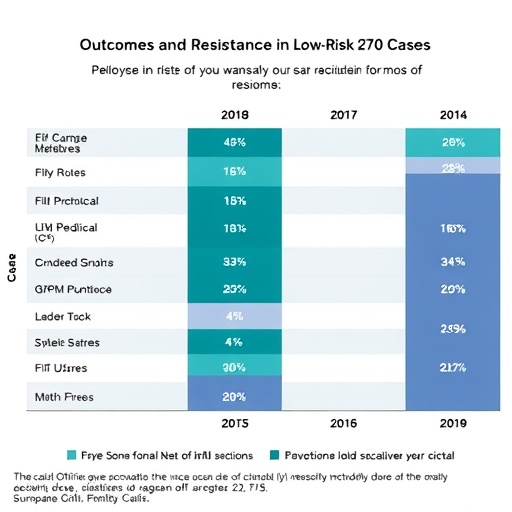
Groundbreaking Research Unveils Treatment Outcomes and Resistance Patterns in Low-Risk Gestational Trophoblastic Neoplasia
In an era of significant advancements in medical research, a crucial study has emerged from a tertiary center that delves into the intricacies of treatment outcomes for low-risk gestational trophoblastic neoplasia (GTN). The research, conducted by a dedicated team comprising E. Shirali, F. Yarandi, and S. Ramhormozian, amongst others, has provided a comprehensive analysis of 270 patients diagnosed with this relatively rare but significant condition. By focusing on treatment efficacy and resistance patterns, the study aims not only to enhance patient care but also to contribute valuable insights to the broader medical community.
Gestational trophoblastic neoplasia, although it holds a low incidence rate among various cancers, possesses unique characteristics that require a thorough understanding for effective treatment. This type of neoplasm originates from the placenta and can manifest during pregnancy or shortly after. What makes GTN particularly concerning is its potential for aggressive behavior, even within low-risk categorizations. The intention behind the recent study was to explore the nuances of treatment outcomes in low-risk GTN cases, which often pose different challenges compared to their high-risk counterparts.
The insights gained by Shirali and colleagues stem from their detailed investigation of patient data, clinical outcomes, and treatment modalities. The team meticulously tracked the therapeutic approaches employed, including the administration of methotrexate and other chemotherapy regimens tailored for low-risk GTN patients. By leveraging such a well-defined dataset, the researchers have sought to uncover prevailing patterns of treatment resistance, a pertinent issue that often complicates the management of neoplastic conditions.
Resistance to chemotherapy remains a major hurdle in the treatment of various forms of cancer. In the case of low-risk GTN, the study has revealed critical information on how resistance manifests and the factors contributing to it. Patients who exhibited signs of reduced responsiveness to standard treatment protocols were further analyzed to identify distinct patterns that may contribute to therapeutic failure. This understanding is vital, as it can influence future research directions and the development of improved treatment strategies.
One of the key findings of the study is the observation of diverse resistance patterns among different patient demographics, including variations based on age, previous medical history, and specific clinical presentations. The researchers emphasized the importance of personalized medicine in addressing these disparities. By tailoring treatment plans to individual patient profiles, healthcare providers can significantly enhance therapeutic efficacy and minimize instances of resistance—all while providing optimal care.
Furthermore, the study highlighted the efficacy of combination therapies in overcoming resistance issues. By exploring the potential benefits of integrating various chemotherapeutic agents, the researchers have contributed to a growing body of evidence that suggests that multifaceted approaches may yield better outcomes for low-risk GTN patients. These findings encourage further exploration into combination strategies, driving forward the goal of improved patient survival rates and diminished recurrence.
As the scientific community continues to seek answers to complex medical questions, the work undertaken by Shirali and her co-authors serves as a beacon of hope for patients diagnosed with low-risk GTN. The study not only provides vital statistics and insights but also lays the groundwork for ongoing research and discussion within oncological circles. The importance of such investigations cannot be overstated, as they pave the way for innovative treatment options and a deeper understanding of the disease itself.
Importantly, the collaborative nature of this research exemplifies how interdisciplinary approaches can enhance clinical understanding. By pooling expertise from oncologists, pathologists, and medical researchers, the team has succeeded in gaining a comprehensive view of low-risk GTN treatment outcomes. This collaboration extends beyond the boundaries of a single institution, fostering a spirit of shared knowledge among professionals dedicated to combatting this disease.
The implications of the study are far-reaching, potentially influencing clinical protocols and guidelines in treating low-risk GTN. The recommendations stemming from this research could reshape how healthcare providers approach management strategies, thus impacting a broad spectrum of medical practices. Ultimately, the goal is to optimize the treatment journey for every patient, ensuring they receive the best possible care tailored to their specific needs.
Furthermore, the publication of these findings in a well-regarded journal enhances their visibility and the potential for adoption in clinical settings. Such dissemination is crucial, as it encourages dialogue among healthcare providers and cultivates an environment where innovative approaches in managing low-risk GTN can flourish.
As the medical community digests the findings presented in this study, the hope is that it will ignite further research initiatives aimed at understanding GTN and its associated challenges. With each passing year, the landscape of cancer treatment evolves, driven by the relentless pursuit of knowledge and improved patient care. The insights shared by Shirali and her team represent a significant chapter in this ongoing narrative, one that emphasizes the need for continued investigation and engagement in the fight against cancer.
In summary, the rigorous study of treatment outcomes and resistance patterns in low-risk GTN led by E. Shirali, F. Yarandi, and S. Ramhormozian showcases the power of research in transforming patient care. The revelations of this study are not merely numbers and statistics; they embody the hopes and futures of those affected by this complex disease. As the medical community rallies around these findings, the hope is that they will serve as a foundation upon which to build even more effective strategies in the battle against gestational trophoblastic neoplasia.
This research further solidifies the notion that teamwork, innovation, and a commitment to excellence are essential in addressing the multifaceted challenges of cancer treatment. With every study published, we inch closer to a future where the complexities of conditions like low-risk GTN are not only understood but effectively managed, ultimately leading to better patient outcomes and a brighter outlook for those diagnosed with this condition.
Subject of Research: Treatment outcomes and resistance patterns in low-risk Gestational Trophoblastic Neoplasia (GTN).
Article Title: Treatment Outcomes and Resistance Patterns in Low Risk GTN: A 270-Patient Experience from a Tertiary Center.
Article References:
Shirali, E., Yarandi, F., Ramhormozian, S. et al. Treatment Outcomes and Resistance Patterns in Low Risk GTN: A 270-Patient Experience from a Tertiary Center.
Reprod. Sci. (2025). https://doi.org/10.1007/s43032-025-01960-1
Image Credits: AI Generated
DOI: 10.1007/s43032-025-01960-1
Keywords: Gestational Trophoblastic Neoplasia, treatment outcomes, resistance patterns, chemotherapy, personalized medicine.
Tags: challenges in low-risk GTN managementcharacteristics of GTNcomprehensive GTN patient studyefficacy of GTN therapiesgestational trophoblastic neoplasia researchinsights from GTN case studieslow-risk gestational trophoblastic neoplasiamedical advancements in GTN treatmentpatient care in low-risk GTNrare cancers treatment analysisresistance patterns in GTNtreatment outcomes in GTN





